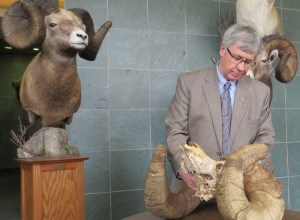
A recently discovered pair of bighorn sheep horns will likely break the world record for the largest ever discovered.
Alberta Fish and Wildlife Enforcement officers found the 18-kilogram, 531-centimetre behemoths on a sweep near the former Gregg River mine site just outside of Jasper National Park.
Carrie Sancartier, a spokesperson for Alberta Environment and Sustainable Resource Development, said the horns belonged to a ram that likely died of natural causes over the winter.
Sheep horns are like trees in that they have rings that can help determine their age. Cartier said the officers who found the skull guess the ram it belonged to lived to be between 10 and 12 years old, based on the deep ridges in the horns. Typically, bighorn sheep live to be about 14.
Sancartier explained that while initial measurements of the horns show they are larger than any previously discovered, it could be several months before the record is confirmed.
It will take time for the horns to properly dry out, and only once that has happened will representatives from Boone and Crockett—the group that tracks records for big game—take a final confirmation measurement.
After the required 60 days of drying, the American organization will determine if the horns break the current 529 centimetre record. To do that, they’ll use an official score sheet and photos that will be looked over by a special panel of judges.
According to Boone and Crockett, every single world record pair of bighorn sheep horns have come from Alberta, which Sancartier said is because “the habitat is just right for them here.”
Sancartier had a chance to see the horns last week, and said they are “pretty impressive.” She also commented that such a healthy specimen “confirms that Alberta has some of the best hunting opportunities in the world, and a wide variety of hunting opportunities. It also confirms our responsible management of bighorn sheep in the province.”
Alberta has a stable, healthy population of about 6,500 bighorn sheep, not including those found in the province’s national parks. Adult males typically grow to be about 135 kilograms, and graze on grasses and flowering plants.
The potentially record breaking skull was found on a sweep by Fish and Wildlife Enforcement officers, as part of their ongoing wildlife enforcement program. The organization conducts the sweeps each year partly to help prevent trespassing on the reclaimed mine site, and to discourage unlawful possession of skulls.
But the sweeps also help the organization assess the health of local populations, and understand the number of animals that died during the winter.
Skulls like the one recently discovered help provide “valuable biological data for our scientists,” Sancartier said.
Sancartier explained that while the skull will remain locked up until the record is confirmed, Minister of Environment and Sustainable Resource Development Robin Campbell would like to see it made available for the public to view.
“We just don’t know yet how or what that would look like,” she said.
